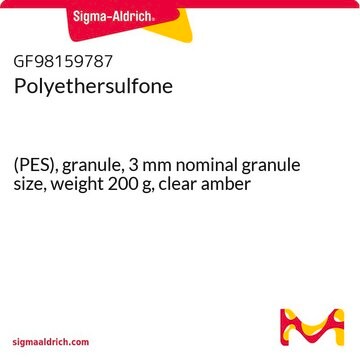939722
Sulfonated polysulfone

proton conducting polymer, degree of sulfonation 70%
Sinónimos:
Sulfonated aromatic polymer for fuel cells and PEMs, Sulfonated poly(arylene ether sulfone) ionomer
About This Item
Productos recomendados
description
degree of sulfonation: 60-90%
Quality Level
form
powder
mol wt
20-80 kDa
color
white to beige
mp
>300 °C
functional group
sulfonic acid
polymer architecture
shape: linear
InChI
1S/C12H8F2O8S3.C12H8F2O2S.C12H10O2.2Na/c13-9-3-1-7(5-11(9)24(17,18)19)23(15,16)8-2-4-10(14)12(6-8)25(20,21)22;13-9-1-5-11(6-2-9)17(15,16)12-7-3-10(14)4-8-12;13-11-5-1-9(2-6-11)10-3-7-12(14)8-4-10;;/h1-6H,(H,17,18,19)(H,20,21,22);1-8H;1-8,13-14H;;
InChI key
MSKVMJLWNYCWLA-UHFFFAOYSA-N
General description
Application
Moreover, sulfonated aromatic polymers are employed in water treatment membranes for processes like reverse osmosis, nanofiltration, and ultrafiltration. Their chemical resistance allows them to withstand harsh environments while maintaining high water permeability, effectively separating and purifying water. These polymers are also explored for their potential in gas separation membranes, where they can selectively separate gases for various industrial processes. Continued research and development in this area promise further advancements and innovations in fuel cells, energy storage, water treatment, and gas separation.
related product
Storage Class
11 - Combustible Solids
flash_point_f
Not applicable
flash_point_c
Not applicable
Certificados de análisis (COA)
Busque Certificados de análisis (COA) introduciendo el número de lote del producto. Los números de lote se encuentran en la etiqueta del producto después de las palabras «Lot» o «Batch»
¿Ya tiene este producto?
Encuentre la documentación para los productos que ha comprado recientemente en la Biblioteca de documentos.
Nuestro equipo de científicos tiene experiencia en todas las áreas de investigación: Ciencias de la vida, Ciencia de los materiales, Síntesis química, Cromatografía, Analítica y muchas otras.
Póngase en contacto con el Servicio técnico








